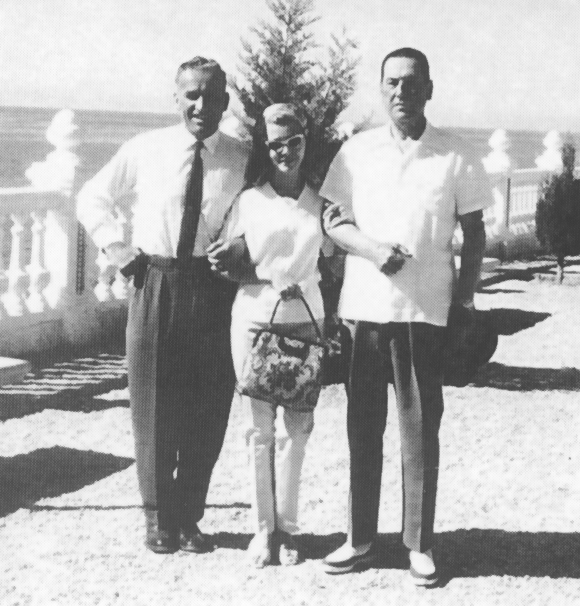WW2: SUPERMAN: SUPER-SOLDIER: Eagle of the Eastern Front: Hans Ulrich Rudel – My Comments
[Rudel is fascinating. I'm actually reading the book he wrote at the moment, in between dashing around. I will return to Rudel and will do videos about him and other white, especially European super-soldiers, like those amazing Fins. Rudel's original book was written in German, and it seemed it created consternation. Then it was reprinted in English and then there was another English version that was censored. I am reading the uncensored version. What I am curious about is whether there are things in the original German that were dropped even from the uncensored English version. It is fascinating reading his views. He is a very fascinating man. There are interesting twists to him, which I want to discuss. This guy, in my opinion, is the greatest soldier of modern time. In terms of damage done by a single soldier, he must therefore be the greatest soldier of ALL TIME. However, in ancient times, I do wonder how good some of the whites were, especially the Aryans. Perhaps there were Aryans who, single handedly killed dozens, maybe hundreds of enemy? But given the weaponry he had as well as the targets he had, Rudel was incredible. This article below does not tell EVERYTHING, but it gives a bit of an intro to him. There is a fun side to Rudel. He married 3 times. I can only find a photo of one of his wives, and she was extremely attractive. ALL his wives' first names were: URSULA!!!! Quite strange! All I will say is that war on the Eastern Front is not quite what the Jews/Liberals/Brits/Russians all claimed it was. They are lying and twisting a lot of facts. Those Germans were incredible as were the other Europeans who fought alongside them. I did notice that Rudel was incensed by witnessing the Romanians fleeing from Stalingrad before the Soviets had even arrived. He did say good things about the Spanish Blue legion. Generally the Romanian army fought well and did a lot in support of the Germans. Jan]
Until very recently the remote forward airstrip had been deep inside Soviet Russia, but now it was Nazi territory. Lieutenant Hans-Ulrich Rudel and the rest of his dive bomber wing had gathered in mid-September 1941 to strike another blow in Operation Barbarossa, Germany’s campaign to conquer the USSR. Out in the Gulf of Finland, the Soviet Baltic Fleet’s 23,000-ton dreadnought Marat was hurling 12-inch, 1,000-pound shells 18 miles onto German forces encircling Leningrad. The men of Sturzkampfgeschwader 2 (StG.2), flying Junkers Ju-87B Stukas, had been tasked with sinking the troublesome ship.
It would be nothing like raining bombs and fear over fleeing enemy infantry and civilians, as Stukas had across Spain, Poland, Belgium and France. And Rudel had flown his first combat mission just three months earlier.
| Blitzkrieg: German newsreel footage |
His first “flight,” at age 8, had been a jump off a roof with an umbrella—in 1924 it was not yet a cliché—that earned him a broken leg. Young Rudel, an avid skier and athlete, came of age in early 1930s Germany at the same time as Nazism and the dive bomber. Plummeting from on high with sirens wailing and bombs whistling, Stukas struck terror long before they struck targets. Yet withstanding rapid changes in air pressure as he plunged thousands of feet, not to mention near-blackout on pull-up, proved difficult for Rudel. And as the son of a Lutheran minister, he didn’t exactly fit into the Stuka fraternity. “He doesn’t smoke, drinks only milk, has no stories to tell about women and spends all his free time playing sports,” wrote one of his instructors. “Senior Officer Cadet Rudel is a strange bird!”
He spent the Polish invasion as a backseat observer in reconnaissance planes, and sat out the Battle of Britain and the Balkan and Cretan campaigns. Not until the invasion of Russia was he at last given a combat seat. With near-complete air superiority on its side, the Stuka was back in its element—relentless blitzkrieg.
In his first day of battle, Rudel flew four missions. In a little over a month he flew 100, receiving the Iron Cross First Class and new respect from his flying mates. “He is the best man in my squadron!” claimed Captain Ernst-Siegfried Steen. “But this crazy fellow will have a short life.” Rudel later wrote in his memoirs, “He knows that I generally dive too low a level, in order to make sure of hitting the target and not waste ammunition.”
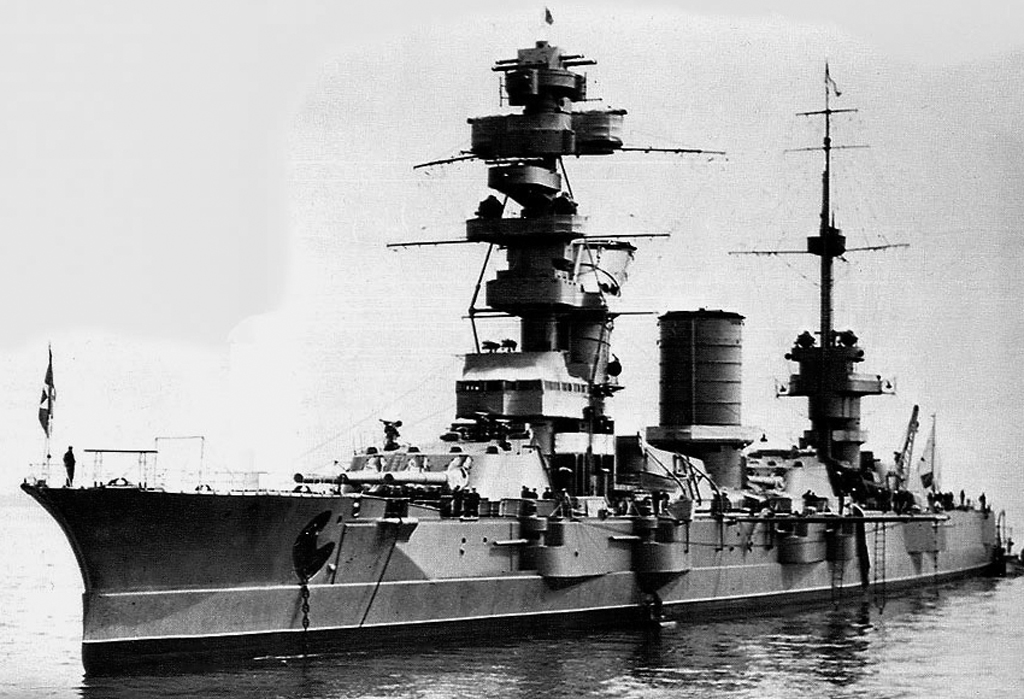 |
| Soviet Navy Dreadnought Marat |
The Stukas had caught Marat out in the Gulf of Finland. Steen’s bomb missed, but Rudel’s 1,000-pounder burst on its aft deck. On the morning of September 23, 1941, a reconnaissance plane spotted the dreadnought undergoing repairs in Kronstadt Harbor, the largest naval base in the Soviet Union, with more than 1,000 shipboard and land-based guns. But StG.2 had just taken delivery of new 2,000-pound armor-piercing bombs, and Rudel said: “I am longing to be off. If I reach the target, I am determined to hit it.”
His backseat gunner, Sergeant Alfred Scharnowski, was with him all the way. The young East Prussian, the 13th child in his family, was accustomed to having the odds against him. “He seldom speaks,” commented Rudel, “…nothing ruffles him.”
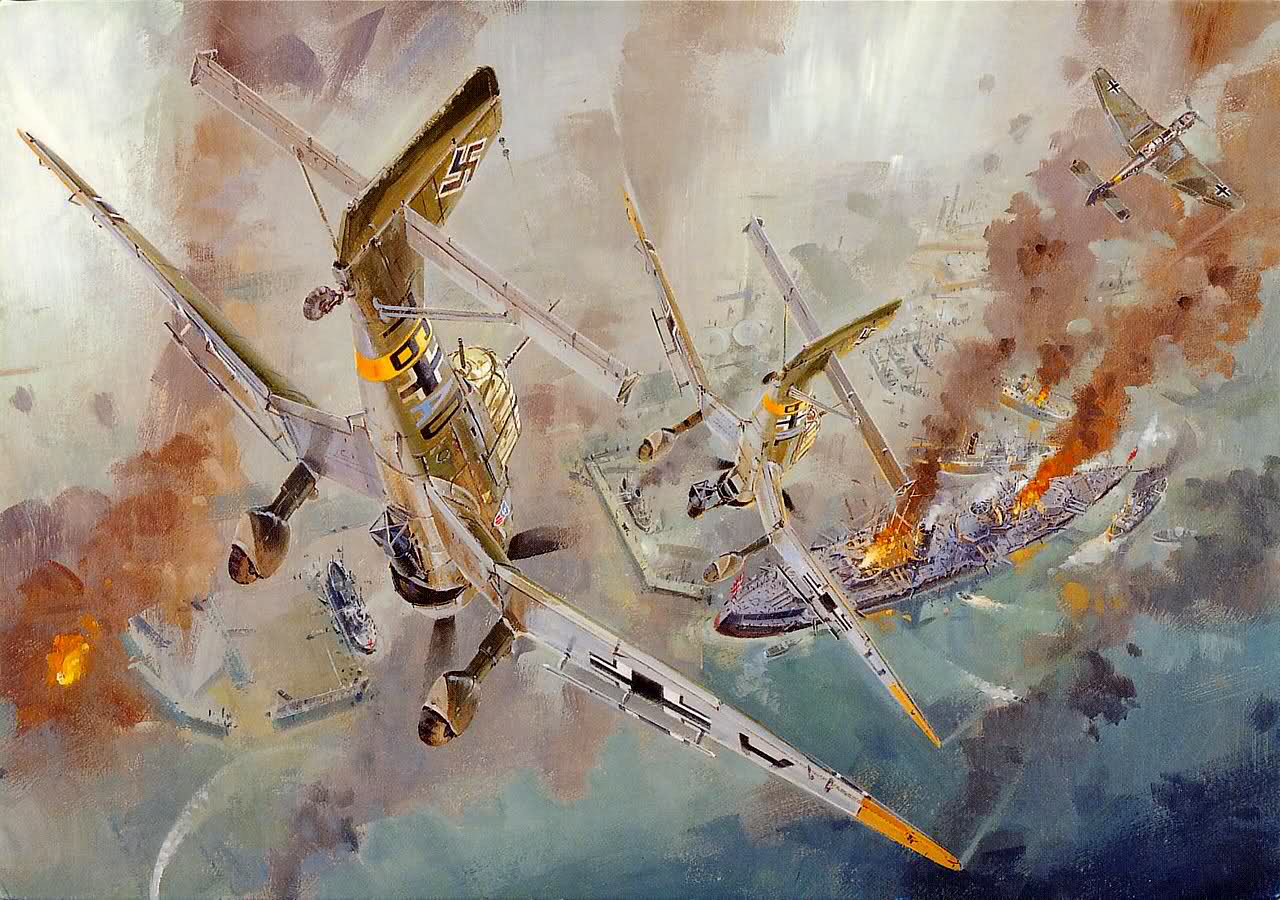 |
| Rudel follows Steen down on Marat. Artist unknown |
On target approach the flak was so intense that the Stukas, bobbing, weaving and dodging, broke formation. Rudel held station on Steen’s wing, and together they bored in. From miles away they could see Marat tied up with the heavy cruiser Kirov at its stern. Wingmounted dive brakes extended for greater stability and accuracy, Steen pitched over into the attack, with Rudel right behind him. The airspeed indicator wound up as the altimeter wound down. “I have already picked up Marat in my sights,” Rudel recounted. “We race down towards her; slowly she grows to a gigantic size. Now all their A.A. guns are directed at us.”
 |
| Marat blows up. Artist unknown |
Steen closed his brakes, trying to get down through the flak before it blew him out of the sky. Rudel cut his brakes as well, “going all out. I am right on his tail, traveling much too fast and unable to check my speed.” He passed so close to the lead plane that he could see Steen’s rear gunner, Sergeant Helmut Lehmann, looking terrified that Rudel would ram them. Marat loomed up below, “large as life in front of me. Sailors are running across the deck….Now I press the bomb release switch on my stick and pull with all my strength.”
Already too low to use the Stuka’s automatic dive-recovery system, Rudel was also well below his bomb’s 3,000-foot safe release height. “My acceleration is too great,” he wrote. “My sight is blurred in momentary blackout… when I hear Scharnowski’s voice: ‘She is blowing up, sir!’”
| 1. Aerial shot, Marat blows up 2. Post-mission recon photo: damage to Marat 3. Marat with bow blown off |
They had pulled out a dozen feet or so above the water. Behind them Rudel saw a 1,200-foot pillar of smoke and fire billowing from the battleship. His bomb had exploded in an ammunition magazine. Marat’s bow had blown off.
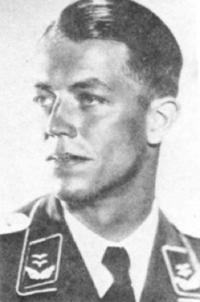 |
| Hauptmann Ernst-Siegfried Steen |
The Stukas regrouped at their field for a go at the cruiser Kirov. Taxiing for takeoff, Steen’s plane mired in soft ground, so he switched to Rudel’s Stuka. Rudel had to watch as the CO took off, with Scharnowski still in back. In the midst of their attack dive, they took a hit in the tail. Unable to pull out, Steen aimed the Stuka at Kirov, but hit the sea alongside.
Even Rudel’s ardent Nazism seemed shaken by the incident. “They are lucky to have died,” he later wrote, “at a time when they could still hold the conviction that the end of all this misery would bring freedom to Germany and to Europe.”
Sunk in shallow water, Marat was refloated in a few months and used as a stationary gun battery. After 16 months the encirclement of Leningrad was broken. By that time Adolf Hitler had other goals: Ukrainian wheat. Caspian oil. Stalingrad.
Meanwhile Rudel—now a 500-mission veteran—survived his first Russian winter and a summer commanding a Stuka training unit. He also married his fiancée, Ursula. By the time he rejoined StG.2, flying the new Ju-87D over Stalingrad, the German Sixth Army had already cornered the Russians in 1,000 yards of the Volga River’s west bank.
Stuka bombing precision was essential in this situation. “We have to drop our bombs with painstaking accuracy,” explained Rudel, “because our own soldiers are only a few yards away in another cellar behind debris of another wall.”
 |
| Stukas over the remains of the Stalingrad North manufacturing plant |
On the morning of November 19, 1942, answering a massive Soviet barrage north of the city, Rudel and his pilots overflew their Romanian allies fleeing a wave of Russian infantry. “Relentlessly I drop my bombs on the enemy and spray bursts of M.G. [machine gun] fire [but] with these hordes our attacks are merely a drop in the bucket,” he despaired. And as for the Romanians (who would switch sides in August 1944), “It is a good thing for them I have run out of ammunition to stop this cowardly rout.”
Within days the Sixth Army was encircled. The Stukas flew 10, 15 sorties a day, dawn to dusk around Stalingrad’s shrinking Kessel (cauldron), where Soviets and Nazis fought to the death over wreckage, rubble and their dictators’ prestige. “Because of the uninterrupted sorties and the stiff fighting,” Rudel said, “the whole squadron has at the moment scarcely more than enough aircraft to form one strong flight.”
| World’s first precision-guided munition: Stukas in action |
StG.2 pulled out to a base 100 miles west of the city, only to find Soviet armor bearing down on the airfield. Rudel flew 17 sorties, stopping the last tank himself just a few yards short of his own runway. “We know the strength of the opposition,” he wrote. “It is too late to free the Sixth Army.”
In February 1943, Rudel flew his 1,000th mission, for which the wing gave him a chimney sweep and a pig (both lucky) and an honor goblet (full of milk). He was then invited to Rechlin, Germany, to help test a new concept in anti-tank warfare.
| Gun camera film: Kanonenvogel vs Soviet landing craft |
It had occurred to the German high command that the most efficient way to kill a tank wasn’t by trying to hit it on the roof with a bomb. Armed with two 600-pound cannon pods, the Stuka became slow and unwieldy, unable to dive or carry bombs, but its 6-foot gun barrels could put 37mm tungsten-core shells through square-foot targets from the air at more than 150 yards. This Ju-87G—the Kanonenvogel (Cannonbird) or Panzerknacker (Tankcracker)—would become one of the war’s supreme tank busters, largely in Rudel’s hands.
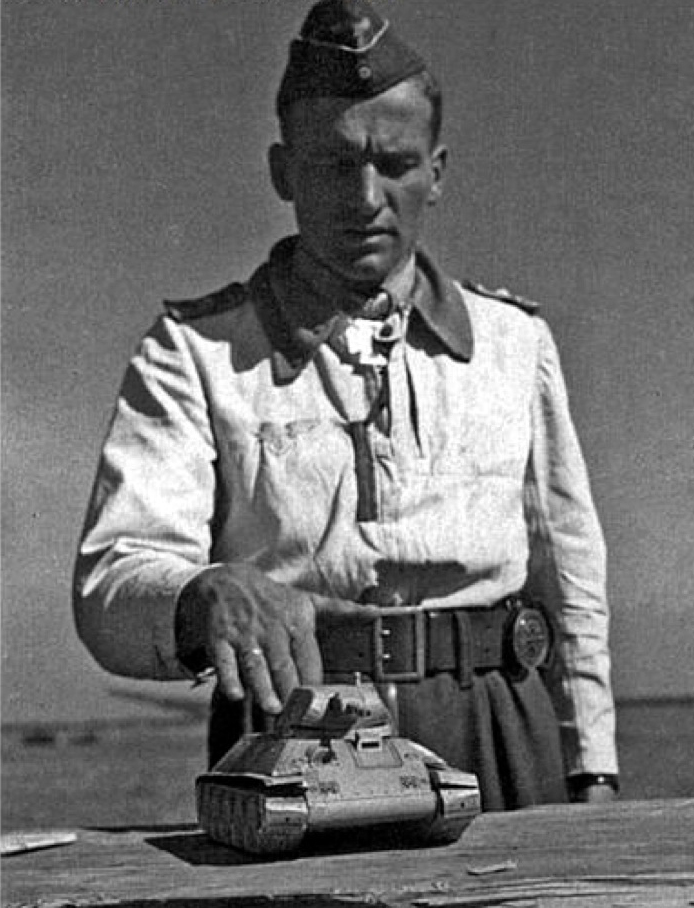 |
| Rudel demonstrates his preferred attack on a model of a Russian T-34 |
Rudel got off to a bad start, shot down by flak on his first combat test, but he made short work of Russian landing craft on the Kuban front. Promoted to captain and awarded the Oak Leaves to his Knight’s Cross by Hitler himself, he agreed to take a Panzerknacker back to the front, just in time for the epic July 1943 Battle of Kursk.
As thousands of German and Russian tanks wheeled and fired at point-blank range below him, Rudel circled behind the enemy armor formations to attack from the rear. In his first attack he disabled four tanks, and by the end of the first day he had bagged 12—the equivalent of a Soviet armor company. He came in so low he risked being caught in the target’s explosion. “This happens to me twice in the first few days when I suddenly fly through a curtain of fire,” he reported. “I come out, however, safe and sound on the other side, even though…my aircraft is scorched and splinters from the exploding tank have riddled it with holes.”
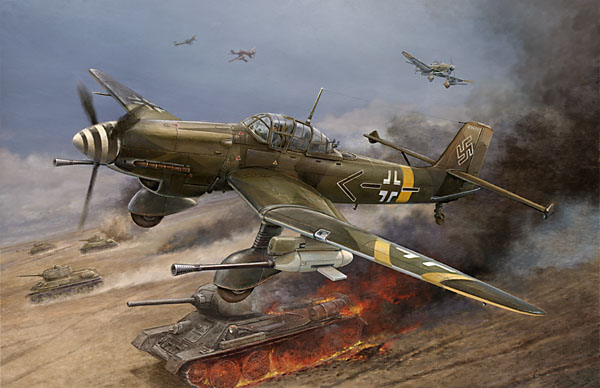 |
| Kanonenvogel by Vincent Wai |
The Luftwaffe already intended the faster Focke-Wulf Fw-190F to replace the Ju-87G in the ground attack role (and Rudel would sometimes fly it), but his name would always be linked to the Stuka. “The evil spell is broken,” he raved about the Panzerknacker. “In this aircraft we possess a weapon which can speedily be employed everywhere and is capable of dealing successfully with the formidable numbers of Soviet tanks.”
Soon appointed wing commander, Rudel formed an elite tank-hunter squadron, a Stuka “fire brigade” tossed into the line wherever the latest Russian breakthrough threatened. His mission tally and score rose dramatically; by November he had racked up 1,500 missions and more than 100 tank kills. His backseater, Sergeant Erwin Hentschel, became the most successful gunner in the Luftwaffe, with more than 1,200 missions and several enemy aircraft to his credit. Rudel recommended him for the Knight’s Cross, but the paperwork had not gone through when he was called to Hitler’s Wolf’s Lair headquarters to receive the Swords to his own Knight’s Cross. Rudel took Hentschel along with him, and by sheer force of personality arranged for the gunner to receive his medal directly from the Führer.
UNREPENTANT EAGLE “We have never fought for a political party, but only for Germany,” said Hans-Ulrich Rudel, who was both a tool and a product of Nazi propaganda. To him nationalism and National Socialism were one and the same. Prior to Operation Barbarossa, he believed the Soviet Union would simply allow its Nazi allies free access to its oil and raw materials; a few days afterward, he was just as willing to believe the Soviets had been ready to invade Germany and were beaten to the punch. By war’s end he was convinced the Allies had betrayed not only Germany but themselves: “They will one day be sorry that in destroying us they have demolished the bastion against Bolshevism.” Rudel was not without sympathizers, even among former enemies. Staunchly conservative RAF group captain Sir Douglas Bader, a fellow ace, ex-POW and (double) amputee, sought a prosthetic leg for him and wrote the foreword for his memoirs, Trotzdem (Nevertheless). In Germany it caused an uproar, but edited and rereleased in English as Stuka Pilot, it found readers in Cold War America. Blaming Germany’s defeat on nationalist German traitors in the high command and advocating renewed war with Russia, Rudel took refuge in fascist Juan and Eva Perón’s Argentina. As consultant to Argentina’s aircraft industry and air force, he influenced future Brig. Gen. Basilio Lami Dozo, who as part of the ruling junta launched the 1982 Falklands War against Britain. Rudel was also an associate of notorious ex-SS commando Lt. Col. Otto Skorzeny, whose network facilitated the escape of hunted Nazis to South America. Rudel’s detractors, as numerous as his supporters, dismissed his astronomical victory tally as fictitious, but politics couldn’t completely detract from his postwar feats. Even one-legged, he never gave up tennis, swimming and skiing. Only bad weather halted his ascent, just 500 feet short of the summit, of 22,841-foot Aconcagua, the highest peak in the Americas. He scaled the world’s fifth-highest volcano, 22,110-foot Llullaillaco, three times. An idol of the resurging Nazi movement, Rudel returned to Germany in 1953 to join the nationalist German Reich Party, perhaps jockeying to become to postwar Germans what World War I ace and Imperial Marshal Hermann Göring had been to their prewar parents. He became so controversial that more than 20 years later two Luftwaffe generals were forcibly retired for publicly supporting him. At Rudel’s funeral in 1982, while two Luftwaffe F-4 Phantom IIs performed a flyover, former comrades raised a Nazi salute. |
Yet the Stukas were unable to halt the relentless Soviet offensives leading into the winter of 1943. Terrible weather shielded the enemy from aerial attack. On one reconnaissance mission, lost in thick fog and running low on fuel, Rudel felt his way down to a forced landing. Hentschel scouted a nearby road jammed with German truck traffic. “We taxi along the very broad highway as if we were driving a car,” Rudel recounted, “obeying the usual traffic regulations and allowing heavy lorries to pass….Many of them think they are seeing a ghost plane.” Nearly 25 miles along, surely some sort of taxi record, an overpass blocked the way. Leaving Hentschel to guard the plane, Rudel caught a ride to base and returned to take off when the weather lifted.
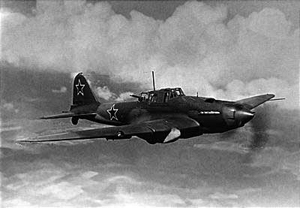 |
| Ilyushin Il-2 Shturmovik |
He also proved the Panzerknacker was effective against Soviet “flying tanks.” Catching a flight of Soviet fighters and Lend-Lease Bell P-39 Airacobras escorting heavily armored Ilyushin Il-2 Shturmoviks to battle, he dropped down alone through the fighter cover. “When I have got to within three hundred feet of [the Shturmoviks] I…loose off a round of anti-tank ammunition from each of my slow-firing cannons.” The infamous Il-2 was no better armored than a T-34 against cannon fire from above. Rudel’s target exploded; he escaped.
In late March 1944, StG.2 (which had been redesignated SG—Schlachtgeschwader, or battle wing—a Luftwaffe admission that the Stuka’s glory days as a dive bomber were over) joined the effort to cut the Soviet bridgeheads over the Dniester River near Nikolayev, Ukraine. On his eighth sortie that day, now-Major Rudel saw one of his crews forced down on the wrong side of the river and landed to pick them up. (He had performed such rescues a half-dozen times before, and had been so rescued himself.) But with two extra passengers, his Stuka bogged down in the mud.
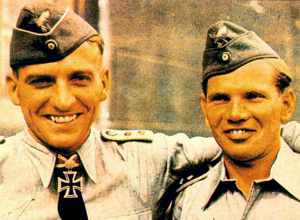 |
| Rudel and Hentschel |
Soviet troops closed in. Rudel, Hentschel and the rest ran several miles in full gear. Doffing flight suits and boots, they slid down riverbank cliffs into the water. The 600-yard-wide Dniester was in full flood, a few degrees above freezing and full of ice. “Gradually one becomes dead to all sensation save the instinct of self preservation,” Rudel recalled. His athletic training saved him: Last into the water, he was second to reach the far bank. Eighty yards short, gunner Hentschel threw up his arms and went under. Rudel dived back in, but couldn’t find his flying mate. The others were soon captured. Rudel had been shot in the shoulder, and was wet, barefoot and freezing. Although deep in enemy territory, he refused to be taken prisoner. Soviet dictator Josef Stalin had announced a 100,000-ruble reward for the capture of the “Eagle of the Eastern Front,” dead or alive. Rudel sheltered among refugees and locals who had no love for Stalinist Russians, and barely survived his trek across some 30 miles of enemy territory to reach German lines.
His feet were so badly injured that when he next flew he had to be helped into his plane. Yet within the week Rudel chalked up his 1,800th mission, destroyed 17 enemy tanks in one day and went to Hitler’s Berghof retreat to receive the Diamonds to his Knight’s Cross, Germany’s highest decoration at the time. (The Führer permitted him to wear padded flight boots for the ceremony.) Reluctant to risk his hero again, Hitler grounded him, but relented when Rudel said he would refuse the medal if forbidden to fly.
| Rudel as propaganda star: German newsreel footage. Subtitled |
Germany needed heroes that summer of 1944, and Rudel did not disappoint. His count rose: 2,000 missions flown, 300 enemy tanks destroyed. Shot down over Latvia, he crash-landed with his gunner, Ernst Gadermann. Both men were wounded, and both were immediately back in the air. Rudel’s tally now stood at 320 tanks destroyed. He was promoted to lieutenant colonel and appointed commanding officer of SG.2. Shot down again and wounded in the upper right leg, he “escaped” from the hospital to fly, with the leg in a cast. By now he had flown 2,400 missions and notched 460 tank kills—approximately equal to three Soviet tank corps. Colonel General Ferdinand Schörner claimed, “Rudel alone is worth an entire division!”
 |
| Hitler presents Rudel with Germany’s highest honor |
On January 1, 1945, at the Eagle’s Nest, the Nazi western headquarters, in the presence of Col. Gen. Alfred Jodl, Grand Adm. Karl Dönitz, Field Marshal Wilhelm Keitel and Imperial Marshal Hermann Goring, Rudel was promoted to colonel and received from Hitler the specially created Golden Oak Leaves with Swords and Diamonds to the Knight’s Cross. No other German soldier has ever received it. Again Hitler ordered him grounded; again Rudel refused. The Führer smiled and said: “Very well then, fly. But be careful, the German people need you.”
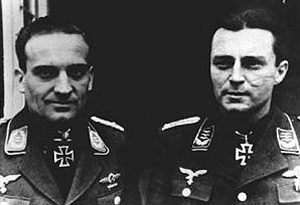 |
| Rudel and Gadermann |
By then the Soviets’ new T-34/85 medium and JS (Josef Stalin) heavy tanks were banging on Nazi Germany’s gate, or grave. On February 8, with his leg still in a cast, Rudel shot up a dozen tanks that had breached the Oder River. He used his last cannon round to score an unlucky 13th, a Stalin, but his Stuka was hit by Soviet 40mm anti-aircraft fire. On the verge of passing out, he called back to Gadermann, “Ernst, my right leg is gone.” Gadermann (who would survive the war with 850 missions and earn his own Knight’s Cross) talked his half-conscious pilot down to a crash landing, pulled him from the wreckage and stopped the bleeding. Rudel woke up in a hospital with his leg amputated below the knee.
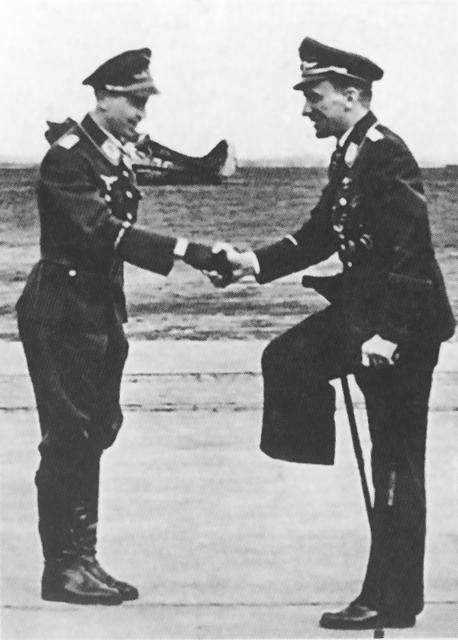 |
| One-legged Rudel is welcomed back by Maj. Karl Kennel, commanding II.SG 2 |
Recovering in a Berlin bunker, Rudel was back in a Stuka by Easter, flying one-legged against Hitler’s orders. (His subsequent tank kills were attributed to the squadron anonymously.) The Führer wanted him to take over a jet unit, but now even Rudel saw the cause was hopeless. By April 26, it was barely possible to fly into the embattled capital. Rudel phoned Hitler’s adjutant, Colonel Nicolaus von Below, offering to land a Stuka on a Berlin road the following morning, and implying he could evacuate the Führer. Hitler refused, and within the week was dead.
Still fighting for Schörner’s Army Group Center in Austria, on its surrender SG.2 was ordered to hand over all equipment to the Soviets. Though Rudel would have preferred to lead his wing on a glorious suicide mission against a Soviet headquarters, instead he sent his men to flee overland, west toward the American lines, on May 8. He and a half-dozen other pilots deliberately crash-landed their planes on an American-held airfield and surrendered.
In all, Hans-Ulrich Rudel was credited with 2,530 missions, one battleship, one cruiser, a destroyer, 70 landing craft, some 800 vehicles, 150 gun positions, numerous armored trains and bridges, 519 tanks and nine aircraft. He had been shot down more than 30 times (never by an enemy pilot) and wounded five times.
Yet Rudel’s fighting philosophy—his life philosophy—came to him not in the air but when he was on foot, on a Ukrainian hillside the same afternoon he swam the half-frozen Dniester River. With a bullet through his shoulder, his comrades gone and enemy troops closing in fast, he remained defiant: “Only he is lost who gives himself up for lost.”


